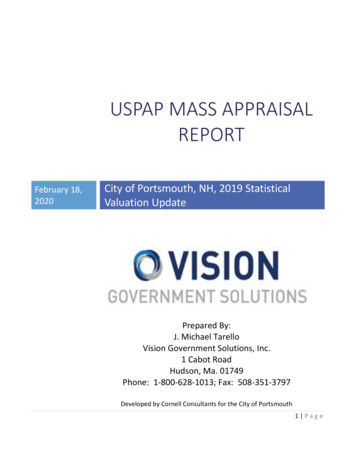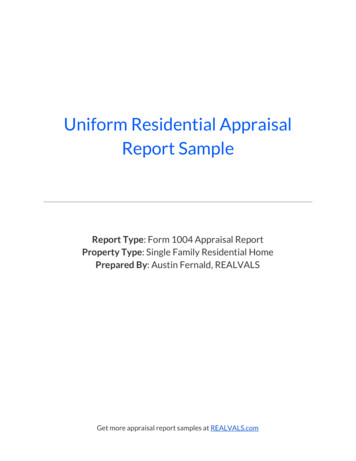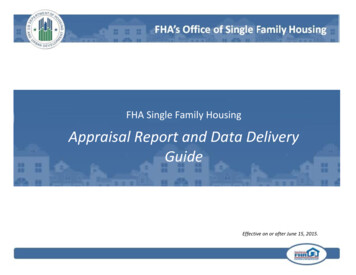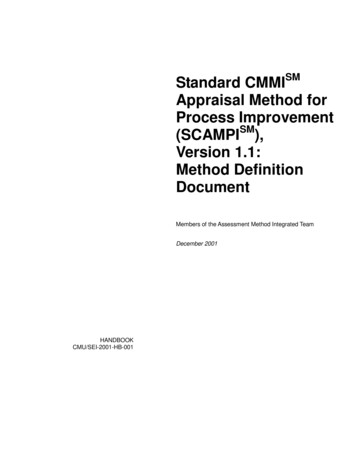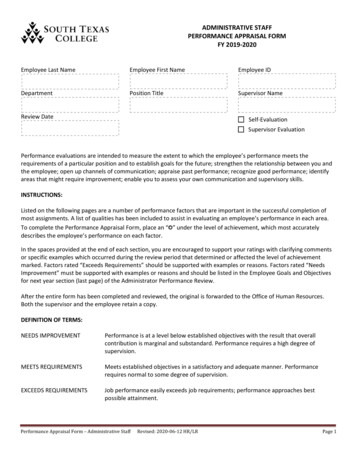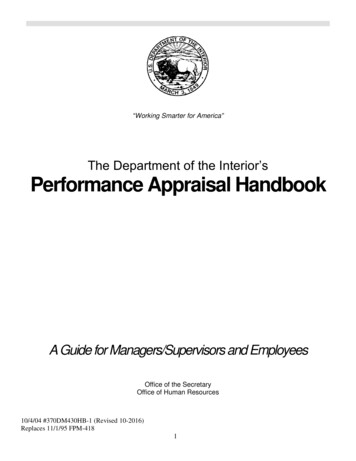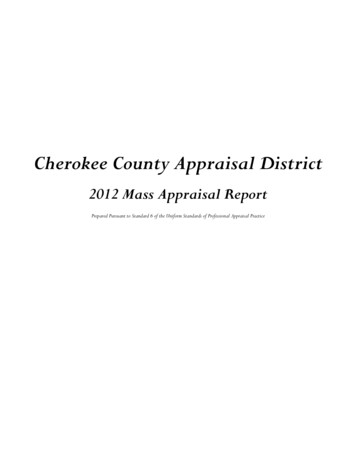
Transcription
Cherokee County Appraisal District2012 Mass Appraisal ReportPrepared Pursuant to Standard 6 of the Uniform Standards of Professional Appraisal Practice
Cherokee County Appraisal District2012 Mass Appraisal ReportIntroductionThe Cherokee County Appraisal District has prepared and published this report to provide our citizens and taxpayers with a better understanding of theDistrict’s responsibilities and activities. This mass appraisal report was written in compliance with Standards Rule 6-7 of the Uniform Standards ofProfessional Appraisal Practice (USPAP) as developed by the Appraisal Standards Board of the Appraisal Foundation. This report has several parts: a generalintroduction and then several sections describing information specific to particular appraisal divisions.The 2012 mass appraisal was prepared under the provisions of the Texas Property Tax Code. Taxing jurisdictions that participate in the District must usethe appraisals as the basis for property taxation. The State of Texas allocates state funds to school districts based upon the District’s appraisals, as tested andmodified by the State Comptroller’s office in a biennial study of value.The 2012 mass appraisal results in an estimate of the market value of each taxable property within the District’s boundaries. Where required by law, theDistrict also estimates value on several bases other than market value. These are described where applicable later in this report.General Assumptions and Limiting ConditionsThe appraised value estimates provided by the District are subject to the following conditions: The appraisals were prepared exclusively for ad valorem tax purposes. The property characteristic data upon which the appraisals are based is assumed to be correct. Physical inspections of the property appraised were performed as staff resources and time allowed and were scheduled based upon the biennialReappraisal Plan developed by the Chief Appraiser and approved pursuant to law by the Board of Directors. Validation of sales transactions occurred through questionnaires to buyers and sellers, review of multiple listing reports from Cherokee MLS andthe interview of real estate professionals. In the absence of secondary confirmation, all sales data obtained was considered reliable. No responsibility is assumed for the legal description or for matters including legal or title considerations. Title to any property is assumed to begood and marketable, unless otherwise stated. All property is appraised as if free and clear of any or all liens or encumbrances, unless otherwise stated. All taxes are assumed to be current. All property is appraised as though under responsible, adequately capitalized ownership and competent property management. All parcel boundary data and structure sketches are assumed to be correct. Any plot plans and/or illustrative material contained with theappraisal records are included only to assist in visualizing the property. It assumes that there is full compliance with all applicable federal, state and local environmental regulations and laws unless noncompliance isstated, defined and considered in the mass appraisal report. It is assumed that all applicable zoning and use regulations and restrictions have been complied with unless a nonconformity has been stated,defined and considered in this mass appraisal report. It is assumed that all required licenses, certificates of occupancy, consents or other legislative or administrative authority from any local, state ornation government or private entity or organization have been or can be obtained or renewed for any use on which the value estimate contained inthis report is based. It is assumed that the utilization of the land and improvements or the properties described are within the boundaries or property lines, and thatthere are no encroachments or trespasses unless noted on the appraisal record. Unless otherwise stated in this report, the appraiser is not aware of the existence of hazardous substances or other environmental conditions. Thevalue estimates are predicated on the assumption that there is no such condition on or in the property or in such proximity thereto that it wouldcause a loss in value. No responsibility is assumed for any such conditions, or for any expertise or engineering knowledge required to discoverthem. All appraisals are as of January 1, 2012. The effective date of this report is July 25, 2012.
Disclosure of InterestThe Chief Appraiser signing this mass appraisal report discloses the following property as being property in which he has interest in: Property ID 116396000, Tract 12, Block 723 of the W. Nutt Survey Abstract 644 Property ID 103564012, Tract 12, Block 1447 of the J. T. Jones Survey Abstract 26 Property ID 103564011, Tract 11, Block 1447 of the J. T. Jones Survey Abstract 26 Property ID 101287010, Tract 10, Block 1229 of the J. T. Jones Survey Abstract 11 Property ID 101287009, Tract 9, Block 1229 of the J. T. Jones Survey Abstract 11The Chief Appraiser signing this mass appraisal report discloses the following party as being a party in which he has personal interest in: None DisclosedProperties in which the Chief Appraiser has an interest were appraised in accordance to state statutes and professional standards. Additionally, a list ofproperties in which the licensed appraisal staff has an interest or an interest in parties is included as an addendum to this report. No appraiser is allowed toappraise properties or influence the appraisal of properties within the jurisdiction of the District in which they have an interest or an interest in a partywithin three degrees of consanguinity by agency rule.Definition of ValueExcept as otherwise provided by the Texas Tax Code, all taxable property is appraised at its “market value” as of January 1. Under the Tax Code, “marketvalue” means the price at which a property would transfer for cash or its equivalent under prevailing market conditions if: exposed for sale in the open market with a reasonable time for the seller to find a buyer; both seller and buyer know of all the uses and purposes to which the property is adapted and for which it is capable of being used and of theenforceable restrictions on its use, and; both the seller and buyer seek to maximize their gains and neither is in a position to take advantage of the exigencies of the other.DepartureTHE TAX CODE DEFINES SPECIAL APPRAISAL PROVISIONS FOR THE VALUATION OF SEVERAL DIFFERENT CATEGORIES OF PROPERTY THAT DIFFERSPECIALLY APPRAISED PROPERTY IS TAXED ON A BASIS OTHER THAN MARKET VALUE AS DEFINED ABOVE. THESEFROM 100% MARKET VALUE.CATEGORIES INCLUDE LIMITATION ON RESIDENTIAL HOMESTEAD PROPERTY (§23.23, TAX CODE) LIMITATION OF HIGHEST AND BEST USE ON HOMESTEAD PROPERTY (§23.01 (C), TAX CODE) RESTRICTION ON APPRAISALS FOR PROPERTIES SUBJECT TO PRIOR YEAR ADMINISTRATIVE REVIEW (§23.01 (C), TAX CODE) AGRICULTURAL AND TIMBER PROPERTY (CHAPTER 23, SUBCHAPERS C, D AND E, TAX CODE) REAL AND PERSONAL PROPERTY INVENTORY (§23.12, TAX CODE) CERTAIN TYPES OF DEALER INVENTORY (§23.121, 23.124, 23.1241 AND 23.127, TAX CODE) NOMINAL (§23.18) OR RESTRICTED USE PROPERTIES (§23.83).Properties AppraisedThe mass appraisal model appraised all taxable real and business personal property known to the District as of the date of this report, with the exception ofcertain properties on which valuation was not complete as of the date of this report. These, by law, will be appraised and supplemented to the jurisdictionsafter equalization. The property rights appraised were fee simple interests, with the exception of leasehold interests in property exempt to the holder of theproperty’s title. The description and identification of each property appraised is included in the appraisal records submitted to the Cherokee CountyAppraisal Review Board as required by law.
Scope of Work Used to Develop the AppraisalThe mass appraisal model appraised all taxable real and tangible business personal property within the boundaries of the Cherokee County AppraisalDistrict, which encompasses all of Cherokee County, Texas. This involves approximately 45,000 accounts. The District distributes the work of the appraisalamong several appraisal personnel, as well as, assignment of certain categories of property to the firm of Capitol Appraisal Group, Inc. The followingsections describe, by area of responsibility, the scope of work performed and those items addressed in USPAP Standard 6-7 (k) through (p).The Chief Appraiser, who is the chief executive officer of the District, manages the District. All District employees report to the chief appraiser through theirimmediate supervisor. The District is divided into four divisions: Executive, Collections, Appraisal and 911 Addressing. The Collections Division of theDistrict is charged with the tasks of assessment and collections for all Cherokee County taxing authorities except the County. The 911 Addressing Division isthe primary addressing authority for all of Cherokee County outside of the municipal boundaries of the City of Jacksonville. The Executive Division is madeup of senior management, systems administrator and one office manager and carries the responsibility of managing the fiscal and overall operationsmanagement of the District. The Appraisal Division is divided into three different departments: Deeds and Mapping, Records, and finally, Appraisal Staff.The Deeds and Mapping Department handles all ownership transactions via recorded deeds or filed real estate renditions. They initiate each ownershipmodification and also create and maintain plat, county block and subdivision maps. The Records Department answers most calls and over the counterrequests. They also have the duty of computer data entry for all appraisal related items. Appraisal Staff performs all appraisal related work for real andbusiness personal property in the jurisdiction. Additionally, they handle all property owner requests for value, special appraisal and equalization questions,as well as, Appraisal Review Board cases. The District’s appraisers are subject to the provisions of the Property Taxation Professional Certification Act andmust be duly registered with The Texas Department of Licensing and Regulation.The Appraisal District staff consists of 17 (as of the date of this report) employees (depending on staffing arrangements) with the following classifications:4 – Executive Division3.5 – Collections Division1 – 911 Rural Addressing1 – Deeds and Mapping3.5 – Records4 – Field AppraisalWhile the appraisal staff conducts most of the appraisal activities, the District also contracts with Capitol Appraisal Group, Inc. for complex properties,mineral valuation, utility and industrial appraisals.Determination of Highest and Best Use for Real PropertyThe District’s market value appraisals are performed pursuant to Article VIII, Section 1, Texas Constitution, which provides that property must be taxed inproportion to its value as determined by law, §23.01, Tax Code implements this provision as follows:Sec. 23.01. Appraisals Generally.(a) Except as otherwise provided by this chapter, all taxable property is appraised at its market value as of January 1.(b) The market value of property shall be determined by the application of generally accepted appraisal methods and techniques. If the appraisaldistrict determines the appraised value of a property using mass appraisal standards, the mass appraisal standards must comply with the UniformStandards of Professional Appraisal Practice. The same or similar appraisal methods and techniques shall be used in appraising the same orsimilar kinds of property. However, each property shall be appraised based upon the individual characteristics that affect the property's marketvalue, and all available evidence that is specific to the value of the property shall be taken into account in determining the property's marketvalue.
Text of subsection as added by Acts 2009, 81st Leg., R.S., Ch. 619, Sec. 1(c) Notwithstanding Section 1.04(7)(C), in determining the market value of a residence homestead, the chief appraiser may not exclude fromconsideration the value of other residential property that is in the same neighborhood as the residence homestead being appraised and wouldotherwise be considered in appraising the residence homestead because the other residential property:(1) was sold at a foreclosure sale conducted in any of the three years preceding the tax year in which the residence homestead is beingappraised and was comparable at the time of sale based on relevant characteristics with other residence homesteads in the same neighborhood; or(2) has a market value that has declined because of a declining economy.Text of subsection as added by Acts 2009, 81st Leg., R.S., Ch. 1211, Sec. 1(c) Notwithstanding any provision of this subchapter to the contrary, if the appraised value of property in a tax year is lowered under Subtitle F,the appraised value of the property as finally determined under that subtitle is considered to be the appraised value of the property for that taxyear. In the following tax year, the chief appraiser may not increase the appraised value of the property unless the increase by the chief appraiseris reasonably supported by substantial evidence when all of the reliable and probative evidence in the record is considered as a whole. If theappraised value is finally determined in a protest under Section 41.41(a)(2) or an appeal under Section 42.26, the chief appraiser may satisfythe requirement to reasonably support by substantial evidence an increase in the appraised value of the property in the following tax year bypresenting evidence showing that the inequality in the appraisal of property has been corrected with regard to the properties that were consideredin determining the value of the subject property. The burden of proof is on the chief appraiser to support an increase in the appraised value ofproperty under the circumstances described by this subsection.Text of subsection as added by Acts 2009, 81st Leg., R.S., Ch. 1405, Sec. 2(c) The market value of a residence homestead shall be determined solely on the basis of the property's value as a residence homestead, regardlessof whether the residential use of the property by the owner is considered to be the highest and best use of the property.The following departure notwithstanding, there is no other specific statute defining highest and best use as it applies in appraisals conducted under the TaxCode, Texas courts have acknowledged that highest and best use is a factor that must be considered in determining market value.DepartureAS IS EVIDENCED BY §23.01 (C), HIGHEST AND BEST USE IS LIMITED IN SPECIFIC CIRCUMSTANCES.Appraisal Performance Tests and Performance Measures AttainedThe Texas Comptroller of Public Accounts conducts an biennial study to determine the degree of uniformity of and the median level of appraisals by theappraisal District within each major category of property constituting at least 5% of the total value in each school district, as required by §5.10, Tax Code.2011 was the last year the Study was performed for Cherokee CAD. The final findings were released February 1, 2012 and can be found at the end of thisreport. All school districts within the District’s area of responsibility were assigned local value and local values were validated in the final report from theState.
Report by Appraisal DivisionAs noted above, the District allocated the work of the mass appraisal among several areas within and without the District. The division of tasks by propertytype typically involves all staff. All field appraisal staff, as well as, the appraisal supervisor, conducts all physical inspections of both real and businesspersonal property. These properties generally break down into four primary categories: Residential, Commercial, Business Personal and AgriculturalValuations. The firm of Capitol Appraisal Group, Inc. conducts all activities related to complex properties, mineral valuation, utility and industrialaccounts. That firm is also charged with the creation and maintenance of USPAP documentation for those areas.Field OperationsScope of WorkThe field operations activities involve appraisers responsible for collecting and maintaining property characteristic data for all commercial, residential,agricultural and business personal property types, which are located within the jurisdictional boundaries of the Cherokee County Appraisal District. Theseactivities involve the field inspection of real and business personal property accounts. Digital photographs are taken by field staff that in turn downloadsthose photographs into the District’s appraisal software system. Data entry of field changes is the responsibility of the Appraisal Division’s RecordsDepartment.Periodic physical review of property is recommended at least every four to six years, according to the International Association of Assessing Officers (IAAO).The Cherokee County Appraisal District policy to inspect all real estate accounts once every three years and business personal property every year. However,sale ratio studies and model calibrations are conducted on an annual basis for all property categories in the District.Procedure for Collecting and Validating DataData collection requires organization, planning and supervision of the field staff. Data collection procedures have been established for all properties. Theappraisers are assigned throughout the jurisdiction of the District to conduct field inspections. Appraisers conduct field inspections and record information ona property record card (PRC).The quality of data used is extremely important in establishing accurate values of taxable property. While production standards are established and upheldfor the various field activities, quality of data is emphasized as the goal and responsibility of each appraiser. New appraisers are trained in the specifics ofdata collection. Experienced appraisers are routinely employed in the effort to reinforce data collection processes during mass reappraisals. A qualityassurance process exists in the Records Department to review data collection by field staff. Errors in data collection are returned to the respective fieldappraiser for correction and reproof.Data collection of real property involves maintaining data characteristics of the property utilizing a CAMA (Computer Assisted Mass Appraisal). Theinformation contained in CAMA includes site characteristics, such as land size, frontage and location; improvement data such as size, composition, quality ofconstruction and physical, economic or function conditions; neighborhood or area types, including micro neighborhood adjustments and digital photographswhen available. Field appraisers use District protocols to establish uniform classification coding and depreciation of real property. All real properties arecoded with this protocol thus enabling the administration of mass appraisal modeling.Data collection for business personal property is not utilized to achieve an overall mass appraisal approach. The majority of business personal property isappraised individually based upon property owner renditions. While is it is true that some properties are appraised based upon the valuations of othersimilar accounts, the multitude of personal property accounts are a one on one appraisal. All business personal property accounts are categorized byStandard Industrial Codes (SIC) as set by the Comptroller of the State of Texas.
Sources of DataThe sources of data collection and verification are typically derived via field inspections, building permits, mechanics liens, Appraisal Review Board hearings,valuation publications, commercial vehicle registrations, property owner correspondence, sales surveys, and real estate professional interviews.Building permit data obtained from the various municipalities and mechanics lien data obtained from the Cherokee County Clerk’s Office trigger annualupkeep inspections on properties with apparent significant changes in value or composition. New improvements are found via several methods. First, theDistrict conducts annual field inspections based primarily on the biennial Reappraisal Plan. Second, a list of new utility connections is provided to theDistrict by the county judge’s office and is used to find new improvements. Finally, mechanic’s liens are filed by contractors and are relayed to the Districtvia the County Clerk’s office on a monthly basis. Data accuracy is also enhanced by the availability of the District’s records on the Internet. Propertyowners do contact us to report data errors via this method and also during informal hearings.Data review of entire neighborhoods, or of individual properties is conducted when ratio studies indicate wide dispersions in the ratio study or out of theordinary ratios for specific properties. Appraisers recheck these neighborhoods or re-inspect individual properties to ascertain the validity of recorded fieldcharacteristics. This process also assists in the protocols to identify data outliers for the statistical analysis.Data MaintenanceData entry of all appraisal related information is performed by the Appraisal Division’s Records Department. This Department is tasked with theresponsibility of creating and maintaining files for each parcel, printing PRC’s for field appraisers, entry of appraisal field changes into the CAMA systemand verifying the validity of coding and sketch information submitted by the field appraiser. As discussed above, field appraisers are responsible fordownloading digital photographs into the CAMA system. The Records Department also maintains and enters all informal and formal hearing informationand changes.Residential ValuationScope of WorkThe Residential Valuation is responsible for developing equal and uniform market values for residential improved and vacant property for ad valorempurposes. Residential improved property encompasses property in municipalities, subdivisions and rural areas. Vacant property typically consists of propertyin residential or rural neighborhood settings.Highest and Best Use AnalysisThe highest and best use of property is the reasonable and probable use that supports the highest present value as of the date of the appraisal. The highestand best use must be physically possible, legally and financially feasible, and productive to maximization of value. The highest and best use of residentialproperty is normally its current use. This is due in part to the fact that residential development, in many areas, through use of deed restrictions and zoning,precludes other land uses. Residential Valuation undertakes reassessment of highest and best use in transition areas and areas of mixed residential andcommercial use. In transition areas, the appraiser must determine the most typical use for property each year by examining the use of recently sold propertyin that area. Similarly, in mixed areas, the appraiser looks for boundaries created by zoning or recent market sales to determine the highest and best use forthat area. However, pursuant to legislative changes in 2009, residential properties receiving a homestead are not subject to this appraisal standard.Instead, according to §23.01 (c), these properties shall continue to be appraised based upon residential use regardless of external factors to the contrary.This creates a departure as noted previously.
Model SpecificationNeighborhood and Market AnalysisThe identification of neighborhoods can be divided into three categories for Cherokee County: subdivisions, municipal neighborhoods and ruralneighborhoods. In each case, the appraiser attempts to localize neighborhoods by geographic boundaries.The determinations of subdivisions and municipal neighborhoods are similar in that the appraiser looks for areas of homogenous property. During thisexamination, type and quality of construction and physical factors such as maintenance and upkeep of homes and vacant tracts are considered. Conversely,rural neighborhoods are determined in large part on the examination of sales prices as compared with other areas within a geo-political boundary. Forexample, a particular area in a rural setting may exhibit higher sales prices for improved and vacant property as compared to other areas within a schooldistrict that has a similar composition of property types. Municipal neighborhoods are classified with Low, Fair, Average and Good codes while ruralneighborhoods are classified with alphanumeric identifiers.Micro-neighborhoods are also a part of municipal neighborhooding. Within any particular neighborhood there can exist areas where the market isrecognizing a discount or premium as compared with similar areas. In these instances, the appraiser still maintains the Low, Fair, Average or Goodneighborhood classification but also adds a second identifier for the micro-area. Micro-neighborhoods are defined in large part by plotting sales activitiesgeographically and using this geographical tool to identify these areas. In each instance, the second identifier contains a percentage adjustment. Thisadjustment modifies the properties as a discount or premium off of the baseline schedule.Description of Residential Improvement ModelThe modeling techniques used by the District allow for specific adjustment for each category of property in the county. To begin, each site built improvedresidence is classified based upon type of exterior siding. Properties with brick-veneer are classified as a type “M” property. Properties with frame, vinyl oraluminum, log or other non-brick sidings are classified as type “F” property. Currently, metal sided structures are also classified as type “F”. There are alsoproperties with mixed siding composition. For example, a home may only have a brick veneer front with frame siding on the remainder of the house. In thiscase, the appraiser must make a determination on the predominate siding when classifying the property.Each type of property as described above is further assigned a numeric code that corresponds to the quality of construction of the improvement. Thesebreakdowns of quality loosely follow the suggestions outlined in the Marshal and Swift valuation guide for residential property. Coding for quality isdefined by the following table:Quality Code1234567Description of QualitySubstandardLowFairAverageGoodVery GoodExcellentFurther, the model provides for plus ( ) classes for each breakdown. The plus classification is used when an appraiser determines that a particular propertyis somewhat better quality than a category but not quite the quality of the next higher classification. For example, an improvement may be better than fairbut not quite average in quality. In this instance, the appraiser would assign a Fair or “3 ” code. These numeric codes are appended to the “F” or “M”code above. For example, a brick veneer, good quality plus home would have a code of “M5 ”.Following the description of siding type and quality, each code is further differentiated by a neighborhood location code. These codes differ for municipal,rural subdivision, lake property and rural properties. For municipal property, the alpha initial of the city is first used followed by the alpha code for the
type of neighborhood. For example, an average neighborhood in the City of Jacksonville would be “JA”. This also denotes a municipal improvement on a lotless than one acre. For municipal improvements on lots over one acre, an additional “A” for acreage is added to the coding. For example, in the averageneighborhood, City of Jacksonville instance, the code would be “JAA”. This additional acreage delineation only applies to municipal schedules. Lakesubdivisions are identified by an “L” and a numeric code corresponding to the particular lake as set out below:CodeLake DescriptionL1Lake JacksonvilleL2Lake StrikerL3Lake PalestineRural subdivisions are identified by the alpha code for the school district followed by an “RS” for rural subdivision then an alpha indicator for Low, Fair,Average or Good subdivision. In this scheme, a fair quality rural subdivision in Wells ISD would be “WRSF” for Wells Rural Subdivision Fair. Ruralproperties are classified based upon the type of road access it has as set out in this table:Access CodeHPDLAccess DescriptionState HighwayPaved County Road or F.M.Dirt RoadLand LockedFollowing the Access Code is the numeric indicator for the school district:School Code08212315SchoolWellsAltoBullardRuskSchool Code42466281SchoolNew SummerfieldJacksonvilleCarlisleTroupTherefore, for a rural improvement in Alto ISD on a dirt road would have a code of “D08”. There is one exception to this rule in Jacksonville ISD. There isa particular code for certain properties that are not in the city limits of Jacksonville but immediately adjacent to the city. This is a type of buffer zonebetween municipal and rural. This area has a numerical code of “76”.These location codes are appended to the type and quality code and separated by a dash “-“. The following table contains some examples of residentialcoding:CodeF5-RGM3 -JFADescriptionGood Quality Frame Exterior Residence in a GoodNeighborhood in the City of RuskFair Plus Quality Brick Veneer Exterior Residence in a FairNeighborhood in the City of Jacksonville on more than oneacreF4-ARSAAverage Quality Frame Exterior Residence in an AverageRural Subdivision in Alto ISDM4-P46Average Quality Brick Veneer Exterior Residence in on aPaved Road in Jacksonville ISDF3-L1Fair Quality Frame Exterior Residence on Lake JacksonvilleEach one of these code combinations is tied to a specific table of value for that code. These tables are referred to by the District as “improvement schedules”.Each schedule contains a value per square foot of living area for individual stratum of square footage. In this manner, the District is able to modify only
schedules for a select gro
District’s responsibilities and activities. This mass appraisal report was written in compliance with Standards Rule 6-7 of the Uniform Standards of Professional Appraisal Practice (USPAP) as developed by the Appraisal Standards Board of the Appra
